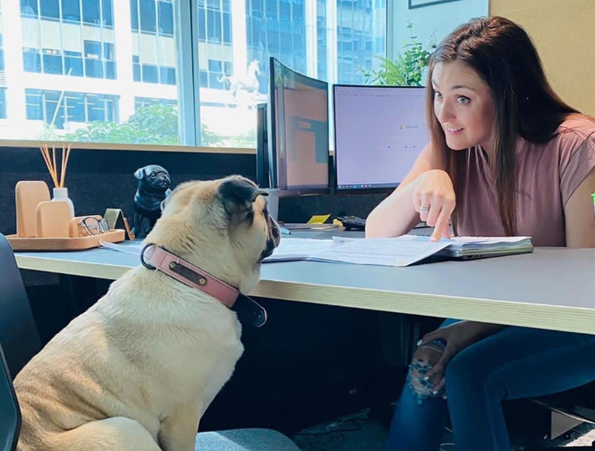THE POSITIVE POWER OF PETS IN THE WORKPLACE
Elevating your day at work with a K-9 visitor
The benefits of pet ownership have long been known. Now, more companies are exploring pets in the workplace as a way to increase overall wellbeing and morale.
Pet-friendly office fitouts are on the rise. At HUB Interiors, our office fitout specialists are often asked to introduce elements supportive of positive workplace experiences, thereby improving retainment and recruitment.
The presence of pets isn’t the first thought that comes to mind when considering office wellness initiatives. But pets are known to improve mental health, and studies show pet owners generally have lower blood pressure.
On this note, Japan’s cat cafes allow access to the health benefits of pet time without the logistics of pet ownership. As this article observes: “…I was surprised by the number of local Japanese businessmen who were there.”
Rather than having time with pets restricted to social hours outside the office, companies are finding ways to incorporate the psychotherapeutic positives of pet interaction into the workplace experience.
Pets in Australia
According to the Pet Industry Association, since the onset of the pandemic Australia has experienced a substantial boom in pet ownership. A quarter of all pet cats were obtained during the pandemic, and a fifth of all pet dogs.
Introducing pets into the workplace is simply an extension of this practice. With work from home and flexibility now paramount, having pets in close vicinity during a workday has been normalised for many pet owners.
In 2021, the Mars Petcare Global P&O Vice President Erica Coletta cited a recent study that showed 90% of employees in pet-friendly workplaces felt connected to their company’s mission, and fully engaged with their work.
Bringing pets to the office
World-wide, Take Your Dog To Work Day takes place annually at the end of June, as set by Pet Sitters International. But bringing pets to the office is presently expanding beyond a designated day on the calendar.
If you decide to introduce pets into the office, forethought and planning are key factors affecting the program’s success: maximising potential for positive results, and minimising the chance of negative outcomes.
Pets that remain in their allocated pens and spaces—lizards, spiders, fish, and rabbits for example—are easily accommodated. Cats and dogs, more prone to moving freely, require further consideration.
Begin with a trial that sees alternating days for different pets, with a minimal number of four legged friends. Ways to reduce the potential for disruption include owner evaluations of their pets for office suitability.
Discussions with pet owners
A clear conversation with pet owners should ascertain whether their pet would likely be comfortable in the office, while ensuring workplace safety is retained. Questions around risk assessment could include:
Does your pet get along well with other animals?
Has your pet undergone behavioural training?
Is your pet comfortable in the presence of strangers?
Does your pet adapt well to new, unknown environments?
Is your pet spayed and properly vaccinated?
Is your pet overly territorial and aggressive?
Is your pet toilet trained?
If a dog, is your pet an incessant barker outside their comfort zone?
A pet who dislikes visits to friends or family homes, the local café, or even a pet park, is likely to find the office overwhelming and uncomfortable. Creating stress for pet and owner, is a counterproductive exercise.
Opting for pet visits
Some firms may choose to reap the benefits of pets without dealing with the logistics of employee pets. Certain pet therapy organisations specialise in bringing friendly pets to office working spaces.
Other workplaces choose to opt for an office pet. While fish have been traditional choices, four legged friends are also viable. Just be aware the office pet will need a home and carer outside office hours.
Points to keep in mind
While pet owners are usually excited at the idea of bringing pets to work, a co-worker may not look favourably on the idea, and their needs must be addressed. Allow feedback prior to implementing the initiative.
Before introducing cats and dogs into the workplace, check the following points:
· Allergies
Allowing animals into the office when an employee suffers an allergy to that type of animal, may be considered a violation of their right to a safe workplace.
· Ailurophobia or Cynophobia
Phobias create serious anxiety. If an employee has an intense fear of cats or dogs, introducing the animal produces an untenable work environment.
When becoming a pet-friendly workplace, remember cleaners, clients, work experience, interns, and other businesses you partner with must be informed, in case they experience the above conditions.
Prepping the office for pets
In some cases, the workplace is just not viable for pets, in terms of assuring animal and staff safety. In other cases, the work space may simply require adjustments to accommodate the presence of pets.
For a pet-friendly Australian office, consider a consult with HUB interiors. We can transform your work place, including the introduction of areas for animal use and protective elements for vulnerable equipment.



